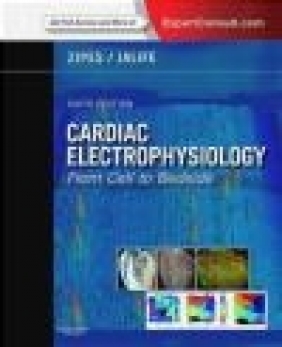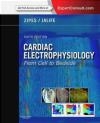Cardiac Electrophysiology: From Cell to Bedside
Jose Jalife, Douglas P. Zipes
Cardiac Electrophysiology: From Cell to Bedside
Jose Jalife, Douglas P. Zipes
- Producent: W.B. Saunders Company
- Rok produkcji: 2013
- ISBN: 9781455728565
- Ilość stron: 1392
- Oprawa: brak formatu
Niedostępna
Opis: Cardiac Electrophysiology: From Cell to Bedside - Jose Jalife, Douglas P. Zipes
Cardiac Electrophysiology: From Cell to Bedside puts the latest knowledge in this subspecialty at your fingertips, giving you a well-rounded, expert grasp of every cardiac electrophysiology issue that affects your patient management. Drs. Zipes, Jalife, and a host of other world leaders in cardiac electrophysiology use a comprehensive, multidisciplinary approach to guide you through all of the most recent cardiac drugs, techniques, and technologies. "An indispensable reference source for anyone interested in having a better understanding of cardiac electrophysiology." - Circulation, review of "Cardiac Electrophysiology, 4th Edition" "A remarkable book that lives up to the promise of its title. It is an encyclopedic review of all areas of adult and pediatric cardiac electrophysiology ... A necessary addition to the library of every cardiology training program and every electrophysiologist, as well as all physicians with a special interest in arrhythmias." - NEJM, review of "Cardiac Electrophysiology, 4th Edition"Section Chapter Title Part I. Structural and Molecular Bases of Ion Channel Function 1 Voltage-Gated Sodium Channels and Electrical Excitablility of the Heart Part I. Structural and Molecular Bases of Ion Channel Function 2 Cardiac Calcium Channels Part I. Structural and Molecular Bases of Ion Channel Function 3 Voltage-Regulated Potassium Channels Part I. Structural and Molecular Bases of Ion Channel Function 4 Inward Rectifying Potassium Channels Part I. Structural and Molecular Bases of Ion Channel Function 5 Membrane Pumps and Exchangers Part I. Structural and Molecular Bases of Ion Channel Function 6 Sarcoplasmic Reticulum Ion Channels Part I. Structural and Molecular Bases of Ion Channel Function 7 Mitochondrial Ion Channels Part I. Structural and Molecular Bases of Ion Channel Function 8 Molecular Organization and Regulation of the Cardiac Gap Junction Channel Connexin Part II. Biophysics of Cardiac Ion Channel Function 9 Biophysics of Normal and Abnormal Cardiac Sodium Channel Function Part II. Biophysics of Cardiac Ion Channel Function 10 Regulation of Cardiac Calcium Channels Part II. Biophysics of Cardiac Ion Channel Function 11 Molecular physiology of slow delayed rectifier channels Part II. Biophysics of Cardiac Ion Channel Function 12 Structural Determinants and biophysical properties of hERG channel gating Part II. Biophysics of Cardiac Ion Channel Function 13 Molecular regulation of cardiac inward rectifier potassium (KIR) channels by pharmacological agents Part II. Biophysics of Cardiac Ion Channel Function 14 Cardiac Stretch-Activated Channels Part II. Biophysics of Cardiac Ion Channel Function 15 Biophysical Properties of Gap Junctions Part II. Biophysics of Cardiac Ion Channel Function 16 Excitation-Contraction Coupling Part III. Intermolecular Interactions and Cardiomyocyte Electrical Function 17 Ion Channel Trafficking Part III. Intermolecular Interactions and Cardiomyocyte Electrical Function 18 Macromolecular Complexes and the Regulation of Sodium Channels Part III. Intermolecular Interactions and Cardiomyocyte Electrical Function 19 Calmodulin and CaMKII as Ca2+ switches for cardiac ion channels Part III. Intermolecular Interactions and Cardiomyocyte Electrical Function 20 Macromolecular Complexes and Potassium Channels Part III. Intermolecular Interactions and Cardiomyocyte Electrical Function 21 Reciprocity of Cardiac Sodium and Potassium channels in the control o Excitability Part III. Intermolecular Interactions and Cardiomyocyte Electrical Function 22 Moecular Organization of the Intercalated Disc Part III. Intermolecular Interactions and Cardiomyocyte Electrical Function 23 Scaffolding Proteins and Ion Channel Diseases Part III. Intermolecular Interactions and Cardiomyocyte Electrical Function 24 Epigenetics in Cardiac Rhythm Diseases Part IV. Cell Biology of Cardiac Impulse Initiation and Propagation 25 The Sinoatrial Node Part IV. Cell Biology of Cardiac Impulse Initiation and Propagation 26 Biological Pacemaker therapy Part IV. Cell Biology of Cardiac Impulse Initiation and Propagation 27 Iintercellular Communication and Impulse Propagation Part IV. Cell Biology of Cardiac Impulse Initiation and Propagation 28 Mechanisms of AV Nodal Excitability and Propagation Part IV. Cell Biology of Cardiac Impulse Initiation and Propagation 29 Cell Biology of the Specialized Cardiac Conduction System Part IV. Cell Biology of Cardiac Impulse Initiation and Propagation 30 Myocyte-Fibroblast Interactions Part V. Models of Cardiac Excitation 31 IONIC MECHANISMS OF ATRIAL ACTION POTENTIALS Part V. Models of Cardiac Excitation 32 Models of the Ventricular Action Potential in Health and Disease Part V. Models of Cardiac Excitation 33 Calcium Signaling in a Cardiomyocyte Model with Realistic Geometry Part V. Models of Cardiac Excitation 34 Rotors and Spiral Waves in the Heart Part V. Models of Cardiac Excitation 35 Supraventricular Arrhythmias in a Realistic 3-D model of the Human Atria Part V. Models of Cardiac Excitation 36 Cardiac Electromechanical Models Part VI. Neural Control of Cardiac Electrical Activity 37 CaV1.2 and beta adrenergic regulation of cardiac function Part VI. Neural Control of Cardiac Electrical Activity 38 cholinergic and constitutive regulation of atrial potassium channels Part VI. Neural Control of Cardiac Electrical Activity 39 Pulomnary vein ganglia and the neural regulation of heart rate Part VI. Neural Control of Cardiac Electrical Activity 40 Neural activity and atrial tachyarrhythmias Part VI. Neural Control of Cardiac Electrical Activity 41 Sympathetic denervation and cardiac arrhythmias Part VII. Arrhythmia Mechanisms 42 Mechanisms of rotor initiation and maintenance in atrial fibrillation Part VII. Arrhythmia Mechanisms 43 Rotors in Human Atrial Fibrillation Part VII. Arrhythmia Mechanisms 44 Atrial circulation, atrial ischemia and fibrillation Part VII. Arrhythmia Mechanisms 45 Molecular pathophysiology of atrial fibrillation Part VII. Arrhythmia Mechanisms 46 Myofibroblasts, Cytokines and Persistent Atrial Fibrillation Part VII. Arrhythmia Mechanisms 47 ROLE OF THE AUTONOMIC NERVOUS SYSTEM IN ATRIAL FIBRILLATION Part VII. Arrhythmia Mechanisms 48 Mechanisms of ventricular tachycardia/fibrillation Part VIII. Molecular Genetics and Pharmacogenomics 49 Genetics of atrial fibrillation Part VIII. Molecular Genetics and Pharmacogenomics 50 Inheritable Sodium Channel Diseases (Long QT Syndrome, Brugada Syndrome) Part VIII. Molecular Genetics and Pharmacogenomics 51 Inheritable potassium channel diseases Part VIII. Molecular Genetics and Pharmacogenomics 52 Arrhythmia Mechanisms in the J Wave Syndrome Part VIII. Molecular Genetics and Pharmacogenomics 53 Inheritable Diseases of Intracellular Calcium Regulation (CPVT, HCM) Part IX. Pharmacologic, Genetic and Cell Therapy of Ion Channel Dysfunction 54 Pharmacologic bases of antiarrhythmic therapy Part IX. Pharmacologic, Genetic and Cell Therapy of Ion Channel Dysfunction 55 Pharmacogenomics of cardiac arrhythmias Part IX. Pharmacologic, Genetic and Cell Therapy of Ion Channel Dysfunction 56 Optogenetic control of heart muscle Part IX. Pharmacologic, Genetic and Cell Therapy of Ion Channel Dysfunction 57 Cell therapy and regeneartive electrophysiology Part X. Diagnostic Evaluation 58 Assessment and Diagnosis of the Patient with a Cardiac Arrhythmia Part X. Diagnostic Evaluation 59 Differential Diagnosis of Narrow and Wide Complex Tachycardias Part X. Diagnostic Evaluation 60 EP Mapping and Navigation Part X. Diagnostic Evaluation 61 CT and MR Imaging for electrophysiology Part X. Diagnostic Evaluation 62 Intracardiac echocardiography for electrophysiology Part X. Diagnostic Evaluation 63 Exercise -induced arrhythmias Part X. Diagnostic Evaluation 64 Holter, event and long term recordings Part X. Diagnostic Evaluation 65 Electrocardiographic imaging in patients with acute coronary syndrome Part X. Diagnostic Evaluation 66 Head-up Tilt Table Testing Part X. Diagnostic Evaluation 67 Electrocardiographic and autonomic testing Part X. Diagnostic Evaluation 68 Monophasic Action Potential Recording Part X. Diagnostic Evaluation 69 T-Wave Alternans Part X. Diagnostic Evaluation 70 Noninvasive Electrocardiographic Imaging (ECGI) of human ventricular arrhythmias and electrophysiologic substrate Part X. Diagnostic Evaluation 71 Genetic testing Part XI. Supraventricular Tachyarrhythmias: Mechanisms, Clinical Features, and Management 72 Sinus node abnormalities Part XI. Supraventricular Tachyarrhythmias: Mechanisms, Clinical Features, and Management 73 Atrial tachycardia: focal, multifocal, and macroreentrant Part XI. Supraventricular Tachyarrhythmias: Mechanisms, Clinical Features, and Management 74 Atrial flutter: typical and atypical Part XI. Supraventricular Tachyarrhythmias: Mechanisms, Clinical Features, and Management 75 Atrial fibrillation: paroxysmal, persistent, and permanent Part XI. Supraventricular Tachyarrhythmias: Mechanisms, Clinical Features, and Management 76 Preexcitation and atrioventricular reentrant tachycardia, variants Part XI. Supraventricular Tachyarrhythmias: Mechanisms, Clinical Features, and Management 77 Atrioventricular nodal reentrant tachycardia, variants Part XI. Supraventricular Tachyarrhythmias: Mechanisms, Clinical Features, and Management 78 Atrial arrhythmias in congenital heart disease, pre and post surgical repair Part XI. Supraventricular Tachyarrhythmias: Mechanisms, Clinical Features, and Management 79 Junctional tachycardia Part XII. Ventricular Tacharrhythmias: Mechanisms, Cliinical Features, and Management 80 Premature ventricular complexes Part XII. Ventricular Tacharrhythmias: Mechanisms, Cliinical Features, and Management 81 Outflow Tract Part XII. Ventricular Tacharrhythmias: Mechanisms, Cliinical Features, and Management 82 Fascicular Part XII. Ventricular Tacharrhythmias: Mechanisms, Cliinical Features, and Management 83 Bundle branch reentry Part XII. Ventricular Tacharrhythmias: Mechanisms, Cliinical Features, and Management 84 Ischemic heart disease Part XII. Ventricular Tacharrhythmias: Mechanisms, Cliinical Features, and Management 85 Nonischemic dilated cardiomyopathy Part XII. Ventricular Tacharrhythmias: Mechanisms, Cliinical Features, and Management 86 Hypertrophic cardiomyopathy Part XII. Ventricular Tacharrhythmias: Mechanisms, Cliinical Features, and Management 87 Right ventricular cardiomyopathy Part XII. Ventricular Tacharrhythmias: Mechanisms, Cliinical Features, and Management 88 Catecholaminergic cardiomyopathy Part XII. Ventricular Tacharrhythmias: Mechanisms, Cliinical Features, and Management 89 Heart Failure Part XII. Ventricular Tacharrhythmias: Mechanisms, Cliinical Features, and Management 90 Noncompaction cardiomyopathy Part XII. Ventricular Tacharrhythmias: Mechanisms, Cliinical Features, and Management 91 Takatsubo cardiomyopathy Part XII. Ventricular Tacharrhythmias: Mechanisms, Cliinical Features, and Management 92 Brugada syndrome Part XII. Ventricular Tacharrhythmias: Mechanisms, Cliinical Features, and Management 93 Long and short QT syndromes Part XII. Ventricular Tacharrhythmias: Mechanisms, Cliinical Features, and Management 94 Andersen-Tawil syndrome Part XII. Ventricular Tacharrhythmias: Mechanisms, Cliinical Features, and Management 95 Timothy syndrome Part XII. Ventricular Tacharrhythmias: Mechanisms, Cliinical Features, and Management 96 J wave syndromes Part XII. Ventricular Tacharrhythmias: Mechanisms, Cliinical Features, and Management 97 Idiopathic ventricular fibrillation Part XII. Ventricular Tacharrhythmias: Mechanisms, Cliinical Features, and Management 98 Sudden infant death syndrome Part XII. Ventricular Tacharrhythmias: Mechanisms, Cliinical Features, and Management 99 Sudden cardiac arrest/death in adults Part XII. Ventricular Tacharrhythmias: Mechanisms, Cliinical Features, and Management 100 Neurologic disorders Part XII. Ventricular Tacharrhythmias: Mechanisms, Cliinical Features, and Management 101 Drug induced Part XII. Ventricular Tacharrhythmias: Mechanisms, Cliinical Features, and Management 102 Congenital heart disease, pre and post surgical repair Part XII. Ventricular Tacharrhythmias: Mechanisms, Cliinical Features, and Management 103 Parasystole Part XIII. Syncope and AV Block 104 Syncope Part XIII. Syncope and AV Block 105 Postural orthostatic tachycardia syndrome Part XIII. Syncope and AV Block 106 Progressive conduction system disease Part XIII. Syncope and AV Block 107 Atrioventricular block Part XIV. Arrhythmias in Special Populations 108 Gender Differences in Arrhythmias Part XIV. Arrhythmias in Special Populations 109 Arrhythmias in Athletes Part XIV. Arrhythmias in Special Populations 110 Arrhythmias in Pediatric Age Group Part XIV. Arrhythmias in Special Populations 111 Sleep Disordered Breathing and Arrhythmias Part XV. Pharmocologic Therapy 112 Standard Antiarrhythmic Drugs Part XV. Pharmocologic Therapy 113 New Antiarrhythmic Drugs Part XV. Pharmocologic Therapy 114 Impact of Nontraditional Antiarrhythmic Drugs (Including CAM) on Sudden Cardiac Death Part XV. Pharmocologic Therapy 115 Prevention of Thromboemboli in Valvular and Non-Valvular Atrial Fibrillaiton Part XVI. Electrical Therapy 116 Implantable Cardioverter-Defibrillators: Technical Aspects Part XVI. Electrical Therapy 117 Implantable Cardioverter-Defibrillators: Clinical Aspects Part XVI. Electrical Therapy 118 Implantable Pacemakers Part XVI. Electrical Therapy 119 Cardiac Resynchronization Therapy Part XVI. Electrical Therapy 120 Newer Applications of Pacemakers Part XVI. Electrical Therapy 121 Catheter ablation: Technical aspects Part XVI. Electrical Therapy 122 Catheter ablation: Clinical aspects Part XVI. Electrical Therapy 123 Ablation for Atrial fibrillation Part XVI. Electrical Therapy 124 Ablation of Supraventricular tachyarrhythmias Part XVI. Electrical Therapy 125 Ablation of Ventricular tachyarrhythmias Part XVI. Electrical Therapy 126 Special ablation approaches: epicardial, other Part XVI. Electrical Therapy 127 Ablation in Pediatrics Part XVI. Electrical Therapy 128 Catheter Ablation in Patients with Congenital Heart Disease Part XVII. Surgery for Arrhythmias 129 Atrial fibrillation and other SVTs Part XVII. Surgery for Arrhythmias 130 Ventricular arrhythmias Part XVIII. New Approaches 131 Vagal stimulation Part XVIII. New Approaches 132 Spinal cord stimulation Part XVIII. New Approaches 133 Left atrial occluders/isolation
Szczegóły: Cardiac Electrophysiology: From Cell to Bedside - Jose Jalife, Douglas P. Zipes
Tytuł: Cardiac Electrophysiology: From Cell to Bedside
Autor: Jose Jalife, Douglas P. Zipes
Producent: W.B. Saunders Company
ISBN: 9781455728565
Rok produkcji: 2013
Ilość stron: 1392
Oprawa: brak formatu


















